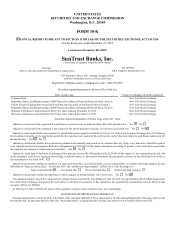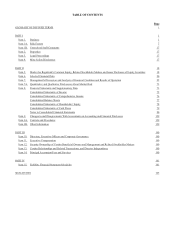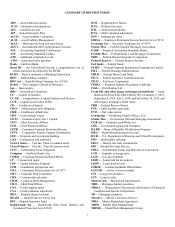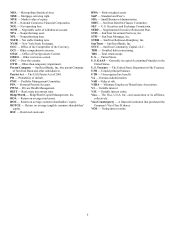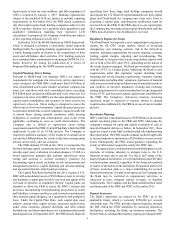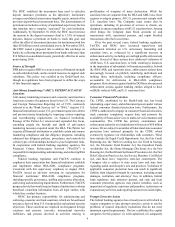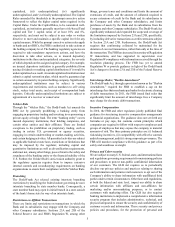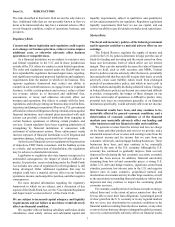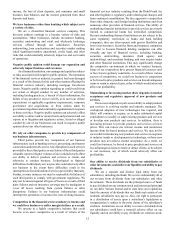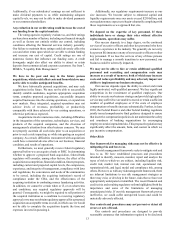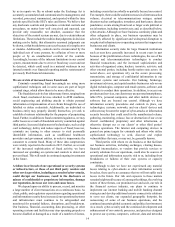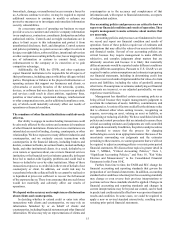SunTrust 2015 Annual Report Download - page 33
Download and view the complete annual report
Please find page 33 of the 2015 SunTrust annual report below. You can navigate through the pages in the report by either clicking on the pages listed below, or by using the keyword search tool below to find specific information within the annual report.5
capitalized, (iii) undercapitalized, (iv) significantly
undercapitalized, and (v) critically undercapitalized. The Capital
Rules amended the thresholds in the prompt corrective action
framework to reflect the higher capital ratios required in the
Capital Rules. Under the Capital Rules, to be considered well-
capitalized, an institution generally must have risk-based Total
capital and Tier 1 capital ratios of at least 10% and 6%,
respectively, and must not be subject to any order or written
directive to meet and maintain a specific capital level for any
capital measure. While the prompt corrective action rules apply
to banks and not BHCs, the FRB is authorized to take actions at
the holding company level. The banking regulatory agencies are
required to take mandatory supervisory actions, and have the
discretion to take other actions, as to insured depository
institutions in the three undercapitalized categories, the severity
of which depends on the assigned capital category. For example,
an insured depository institution is generally prohibited from
paying dividends or making capital distributions if it would be
undercapitalized as a result. An undercapitalized institution must
submit a capital restoration plan, which must be guaranteed up
to certain amounts by its parent holding company. Significantly
undercapitalized institutions may be subject to various
requirements and restrictions, such as mandates to sell voting
stock, reduce total assets, and receipt of correspondent bank
deposits. Critically undercapitalized institutions are subject to
appointment of a receiver or conservator.
Volcker Rule
Through the “Volcker Rule,” the Dodd-Frank Act amends the
BHC Act by generally prohibiting a banking entity from
engaging in proprietary trading and investing in or sponsoring a
private equity or hedge fund. The term “banking entity” covers
insured depository institutions, their holding companies, and
certain other entities and their affiliates. There are limited
exceptions to the prohibition on proprietary trading, such as
trading in certain U.S. government or agency securities,
engaging in certain underwriting or market-making activities,
and certain hedging activities. All permitted activities are subject
to applicable federal or state laws, restrictions or limitations that
may be imposed by the regulator, including capital and
quantitative limitations as well as diversification requirements,
and must not, among other things, pose a threat to the safety and
soundness of the banking entity or the financial stability of the
U.S. Further, the Volcker Rule's anti-evasion authority grant to
the regulatory agencies requires them to impose extensive
internal controls and recordkeeping requirements on banking
organizations to ensure their compliance with the Volcker Rule.
Branching
The Dodd-Frank Act relaxed existing interstate branching
restrictions by modifying the federal statute governing de novo
interstate branching by state member banks. Consequently, a
state member bank may open its initial branch in a state outside
of the bank’s home state by way of an interstate bank.
Restrictions on Affiliate Transactions
There are limits and restrictions on transactions in which the
Bank and its subsidiaries may engage with the Company and
other Company subsidiaries. Sections 23A and 23B of the
Federal Reserve Act and FRB's Regulation W, among other
things, governs terms and conditions and limits the amount of
extensions of credit, and the amount of collateral required to
secure extensions of credit by the Bank and its subsidiaries to
the Company and other Company subsidiaries, and limits
purchases of assets by the Bank and its subsidiaries from the
Company and other Company subsidiaries. The Dodd-Frank Act
significantly enhanced and expanded the scope and coverage of
the limitations imposed by Sections 23A and 23B, specifically,
by including derivative transactions as credit extensions subject
to Section 23A and 23B. Furthermore, the Dodd-Frank Act
requires that conforming collateral be maintained for the
duration of covered transactions, rather than only at the time of
the transaction. The FRB has increased its scrutiny of Regulation
W transactions, and has supported its supervision over
Regulation W compliance with information received through the
resolution planning process. The FRB has yet to amend
Regulation W or provide guidance in light of the Dodd-Frank
Act's changes to Sections 23A and 23B of the Federal Reserve
Act.
Interchange Rules; “Durbin Amendment”
The Dodd-Frank Act, through a provision known as the “Durbin
Amendment,” required the FRB to establish a cap on the
interchange fees that merchants pay banks for electronic clearing
of debit transactions. In 2011, the FRB issued final rules that
significantly limit the amount of interchange fees a Company
may charge for electronic debit transactions.
Incentive Compensation
In 2010, the FRB and other regulators jointly published final
guidance for structuring incentive compensation arrangements
at financial organizations. The guidance does not set forth any
formulas or pay caps, but contains certain principles which
companies are required to follow with respect to employees and
groups of employees that may expose the company to material
amounts of risk. The three primary principles are: (i) balanced
risk-taking incentives, (ii) compatibility with effective controls
and risk management, and (iii) strong corporate governance. The
FRB will monitor compliance with this guidance as part of its
safety and soundness oversight.
Privacy and Cyber-security
We are subject to many U.S. federal, state, and international laws
and regulations governing requirements for maintaining policies
and procedures to protect non-public confidential information
of our customers. The GLB Act requires us to periodically
disclose our privacy policies and practices relating to sharing
such information and permits retail customers to opt out of the
Company’s ability to share information with unaffiliated third
parties under certain circumstances. Other laws and regulations,
at both the federal and state level, impact our ability to share
certain information with affiliates and non-affiliates for
marketing and/or non-marketing purposes, or to contact
customers with marketing offers. The GLB Act also requires
banking institutions to implement a comprehensive information
security program that includes administrative, technical, and
physical safeguards to ensure the security and confidentiality of
customer records and information. These security and privacy
policies and procedures, for the protection of personal and




